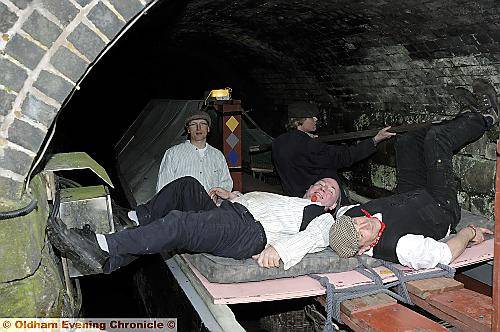Leg it over to Stanedge for tunnel anniversary
Reporter: LEWIS JONES
Date published: 31 March 2011

Photo: Chris Sunderland
Walking on the walls — the traditional “legging” method of navigating the three-mile tunnel, built 200 years ago
A PACKED programme of events has been planned to celebrate 200 years of a local landmark.
The Horseboating Society is hoping crowds will join them to toast the bicentenary of the Stanedge Tunnel that links Diggle and Marsden.
A three-day spectacular has been planned for the landmark weekend from Saturday, with the well-known tradition of legging through the tunnel due to be a highlight.
Horseboating enthusiasts will propel a total of seven boats between the tunnel ends during the celebration, using the proven technique of lying on their backs and walking along the walls.
Sue Day, chair of the Horseboating Society, said: “We’re really looking forward to it. Legging is special because it is the way our ancestors did it.
“We’re hoping that people will join in and walk over the top, that will be exciting to tread in the footsteps of people gone by.
“The tunnel remains one of the great engineering feats, it was a phenomenal achievement at the time and we must always remember that.”
The three-mile tunnel, that travels under the Pennines, was officially opened on April 4, 1811, after 16 years of hard labour.
This year’s anniversary events aim to stay faithful to what is thought was the opening ceremony, when a live band playing Rule Britannia heralded the arrival of the first boat.
As part of the weekend, guided walks will be lead each day, while a wildlife and sensory garden made from recycled lock gates will be officially opened alongside a children’s playground area.
A mosaic project continues through the weekend and arts and craft fairs will take place at the visitors centre in Marsden.
James Dean, visitor services manager for Stanedge Tunnel and Visitor Centre, said: “Stanedge is a unique place and this is a very proud moment for everyone who has played a part in the tunnel’s life, because after 200 years it’s still one of the major landmarks of the waterways.”
Most Viewed News Stories
- 1Dynamic rescue team duo pledge to raise funds for brave Finn
- 2Oldham man caged after 150 wraps of crack cocaine were found during house search
- 3Police probe follows Chadderton pepper-spraying incident
- 4Oldham mayor presents Armed Forces Silver Award to VPS UK
- 5‘Completely inappropriate’ caravan park plans rejected




